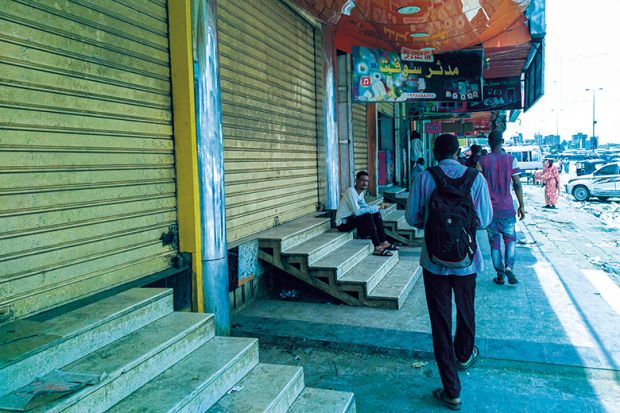When it comes to international student recruitment, you ignore Africa at your peril.
Of the continent’s total population – currently numbering 1.2 billion and projected to hit 2.4 billion by 2050 – 41 per cent are under 15 years of age. Compared with the rapidly ageing societies of East Asia, which comprise the bulk of most universities’ targeted international student markets, Africa offers the most obvious opportunities for recruitment expansion.
Or does it? A year ago, I was part of a US higher education delegation to Sudan, invited by the country’s Ministry of Education to help internationalise its universities after years of financial hardship and civil war. The need from the participating Sudanese universities was overwhelming and all-encompassing, ranging from faculty exchange and student scholarships to English-language courses and even books.
The energy on the American side – which included representatives from Stanford and Texas A&M universities, as well as the Centers for Disease Control and Prevention – was also palpable, fuelled by Sudan’s wealth of natural resources and long history of education that goes back to the ancient Kingdom of Kush. Indeed, the Institute of International Education, which organised the trip, noted that there was more university interest in this visit than in the one it had previously organised to Finland – a country famed for its high scores in the PISA (Programme for International Student Assessment) tests of 15-year-olds’ literacy and numeracy.
However, less than two months after the trip ended, the window to Sudan firmly closed. Massive protests erupted on the streets of Khartoum in reaction to government emergency austerity measures that tripled the price of formerly subsidised goods, such as bread and fuel. The violence and unrest continued well into 2019, even after president Omar al-Bashir was overthrown in April. Any momentum on US collaboration achieved by the delegation visit was lost.
Meanwhile, in February, I travelled to multiple cities in South Africa on a recruitment trip organised by a Johannesburg-based education agent for a contingent of more than 40 university representatives, mostly from the UK and Australia. The trip was to culminate in Zimbabwe, with a series of student fairs at Harare’s most exclusive private schools. Rampant inflation – which would eventually near 175 per cent – had already triggered civil unrest, prompting safety concerns among some of the tour participants. However, the organising agent decided it should go ahead anyway.
Owing to the wide variety of universities involved in the trip, offering specialties in everything from medicine to sports management, the itinerary tended to be broad and wide-ranging, sometimes to the point of inefficiency. And even before we got to Harare, we were struck by the pervasive wealth inequity and racial conflict in Cape Town, Durban and Johannesburg. Nevertheless, the sheer number of students attending our fairs, propelled by a palpable drive to earn a university degree overseas, brought home to me the potential of this market for overseas recruitment. Actually getting interested students enrolled may not necessarily be a slam dunk, but the payoff for persistence was apparent.
Yet what was even more striking was how behind the curve I was. The majority of recruiters on the trip were already playing the long game. They had been visiting the likes of South Africa and Zimbabwe – as well as Botswana, Ghana and Nigeria – for years, their interest stoked by those countries’ high youth populations, relative wealth and English language ability.
One representative of an Irish university had visited Zimbabwe so often that parents of children he had previously recruited took him out to dinner when he returned to Harare. Other universities had tapped into government scholarships for Botswanans to study overseas, or developed deep networks of agents in Nigeria, whose efforts they rewarded with annual “fam” (familiarisation) trips to their home campuses.
In Zimbabwe, it became apparent that the ongoing social and economic problems had only heightened interest in studying overseas. For those high school students whose parents could afford the cost of overseas university tuition, there was a desire to wait out the volatility from the comfort of geographic distance. A student from Harare who might traditionally have pursued a university education in Cape Town and then returned home to work was now rethinking that pathway, perhaps inadvertently benefiting by opening the doors to an even more global career in the process.
Undoubtedly, the obstacles and challenges around recruiting students in Africa are numerous. As my Sudanese example exemplifies, good intentions can be thwarted on the turn of a dime by unpredictable geopolitical factors, while governmental corruption and lack of transparency can make the recruitment landscape difficult to gauge.
However, ignoring the African market is not an option – especially with China aggressively linking African student mobility to its own domestic universities via employment opportunities with Chinese firms in Africa and its ambitious Belt and Road global development strategy.
But it is equally clear that you can’t suddenly just go into Africa when your Chinese recruitment strategy is faltering. The evidence of my trips there is that, to be successful in Africa, you have to have been there, getting traction, all along.
Anna Esaki-Smith is co-founder and managing director of research consultancy Education Rethink, whose inaugural report Rethink China: The End of the Affair examines the state of Chinese student mobility to major host destinations.
后记
Print headline: When recruiting in Africa, play the long game





